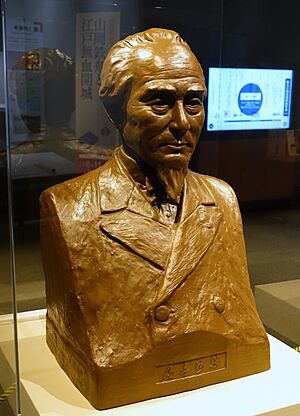Katsu Kaishū facts for kids
Quick facts for kids
Katsu Yasuyoshi
|
|||||
|---|---|---|---|---|---|

Katsu Kaishū (as Katsu Yasuyoshi) in his later years
|
|||||
| Native name |
勝 安芳
|
||||
| Birth name | Katsu Yoshikuni | ||||
| Other name(s) | Katsu Rintarō | ||||
| Nickname(s) | Katsu Kaishū (勝 海舟) Awa Katsū |
||||
| Born | March 12, 1823 Edo, Japan |
||||
| Died | January 21, 1899 (aged 75) Tokyo, Japan |
||||
| Buried |
Senzoku Pond Public Park, Tokyo, Japan
|
||||
| Allegiance | |||||
| Service/ |
|||||
| Years of service |
|
||||
| Rank |
|
||||
| Commands held |
|
||||
| Battles/wars | Boshin War | ||||
| Awards | See Honours | ||||
| Spouse(s) | Tami Masuda Ito 4 other concubines |
||||
| Children | 9 children | ||||
| Relations | Katsu Kokichi (father) Katsu Nobuko (mother) |
||||
| Other work | Military theorist | ||||
| Japanese name | |||||
| Kanji | 勝 海舟 | ||||
| Hiragana | かつ かいしゅう | ||||
| Katakana | カツ カイシュウ | ||||
|
|||||
Katsu Yasuyoshi, also known as Katsu Kaishū, was a very important Japanese leader. He was a statesman and a naval engineer. He lived during a big change in Japan, from the late Tokugawa shogunate to the early Meiji period.
Katsu Kaishū was born Katsu Yoshikuni. His childhood name was Rintarō. He later took the nickname Kaishū from a piece of calligraphy. He became a high-ranking officer in the Tokugawa navy. He is especially remembered for helping with the peaceful surrender of Edo Castle.
Contents
Early Life and Learning
Katsu Yoshikuni was born on March 12, 1823, in Edo, which is now Tokyo. His father, Katsu Kokichi, was a low-ranking samurai for the Tokugawa government.
As a young boy, Katsu Rintarō studied the Dutch language. He also learned about European military science. Because of his skills, the government hired him as a translator. This happened when European countries started trying to connect with Japan. Katsu became known as an expert in Western military technology.
From 1855 to 1859, Katsu was the head naval cadet. He studied at the Nagasaki Naval Academy. This was done with advice from Dutch naval officers.
Military Career and Important Missions
In 1860, Katsu became the captain of the warship Kanrin-maru. This ship helped escort the first Japanese group to San Francisco, California. They were on their way to Washington, DC. Their mission was to officially approve the Harris Treaty.
The Kanrin Maru was built by the Dutch. It was the first Japanese ship to sail to the Western world. Katsu stayed in San Francisco for almost two months. He carefully observed American society, culture, and technology.
After returning to Japan, Katsu held many important jobs in the Tokugawa navy. He argued that Japan needed a strong, united navy. He believed it should be led by professionally trained officers. He thought that promotions should be based on skill, not family background.
From 1863 to 1864, Katsu was the director of the Kobe Naval School. This school became a place for new ideas and reforms.
In 1866, Katsu was chosen to negotiate between the bakufu (shogunate) forces and the anti-shogunal group from Chōshū. Later, he was the chief negotiator for the Tokugawa bakufu. He helped make sure there was a peaceful change of power during the Meiji Restoration.
Even though he understood the anti-Tokugawa side, Katsu stayed loyal to the Tokugawa bakufu during the Boshin War. After the Tokugawa forces lost in late 1867, Katsu negotiated. He arranged for Edo Castle to be surrendered to Saigō Takamori on April 11, 1868. This helped prevent more fighting and destruction.
Later Years and Legacy
After the new Imperial government took over, Katsu moved to Shizuoka. The shogun's old capital was renamed Tokyo. He briefly returned to government work in 1872. He served as Vice Minister of the Imperial Japanese Navy. From 1873 to 1878, he was the first Minister of the Navy.
As Katsu Yasuyoshi, he was one of the most famous former Tokugawa officials. He found work in the new Meiji government. He served as an important advisor on national policy. He also worked to restore the good name of Tokugawa Yoshinobu and Saigō Takamori.
In 1887, he was given the title of hakushaku (count). This was part of the kazoku peerage system. Katsu wrote down his memories in a book called Hikawa Seiwa.
Death
In 1891, Katsu Yasuyoshi bought land near Senzoku-ike kôen (洗足池, Senzoku Pond). He built his retirement home there. He passed away in 1899. He was buried with his wife, Tami, near their home. Their graves are in what is now Senzoku-ike kôen (洗足池公園, Senzoku Pond Public Park) in Tokyo.

Honours
- Count (May 9, 1887)
 Grand Cordon of the Order of the Sacred Treasure (December 1889)
Grand Cordon of the Order of the Sacred Treasure (December 1889) Grand Cordon of the Order of the Rising Sun (February 26, 1898)
Grand Cordon of the Order of the Rising Sun (February 26, 1898)
Order of precedence
- Fourth rank (June 15, 1872)
- Senior fourth rank (February 18, 1874)
- Third rank (December 1887)
- Senior third rank (October 1888)
- Junior Second rank (June 30, 1894)
- Senior second rank (January 20, 1899; posthumous)
See also
 In Spanish: Katsu Kaishū para niños
In Spanish: Katsu Kaishū para niños



